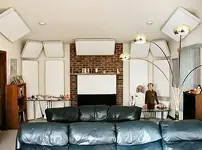If the drywall and studs are acting as membrane absorbers, does that mean a concrete wall has little or no absobtion qualities. Or does it depend on whether it's concrete block, or solid concrete?
Walls only act as membrane absorbers if there is drywall on BOTH sides. IF, you have a studwall in front of a concrete wall, you do NOT want drywall on both faces as this creates a three leaf system, which can actually reduce its effective LF isolation qualities. However, IF the total airgap between drywall and concrete is hermetically SEALED(doubtful), then the whole wall in theory, should act as a dampened(studs and insulation) panel absorber. This would also imply that the concrete would also have a sealant applied to it and all flanking paths sealed in the airgap. What effect the studs would have on the panel I do not know, but I do know this. The transmission loss in two leaf systems is determined by its mass, rigidness, and airgap. It stands to reason that as a membrane absorber, a single wall with both faces shiethed with drywall, also has an absorption coefficient and resonant frequency determined by the mass of the membranes, the depth of the airgap, distance between studs, and distance between floor and ceiling plates. These wall cavities in essence form a box, hence a membrane absorber. A wall cavity with studs spaced 16"oc will have a higher resonant frequency than that of one with studs spaced 24"oc.
It also stands to reason, that a two leaf "box" comprised of a stud wall with one face of drywall and the other of concrete, and the airgap between them is sealed, also creates a "membrane absorber". The question is what affect the studs have on the drywall(membrane) vibration characteristics and frequency. I have seen old studio pictures of membrane absorbers(bass traps) 20 and 30 feet long, but the panels were one continuous panel with NO studs. Usually this was done by splining plywood panels together at the seams.
As to absorption of concrete vs concrete block. ALL materials have an absorption coefficient. Even stone. However, rationality tells me it would be VERY VERY low.

On the other hand, structural transmission of sound in these materials is VERY effective. More so and faster than sound in air. This is ONE of the reasons why concrete floors in studios are isolated from the floors in the control room as sound travels faster in concrete than air. Disclaimer still in force.
fitZ



 On the other hand, structural transmission of sound in these materials is VERY effective. More so and faster than sound in air. This is ONE of the reasons why concrete floors in studios are isolated from the floors in the control room as sound travels faster in concrete than air. Disclaimer still in force.
On the other hand, structural transmission of sound in these materials is VERY effective. More so and faster than sound in air. This is ONE of the reasons why concrete floors in studios are isolated from the floors in the control room as sound travels faster in concrete than air. Disclaimer still in force.
